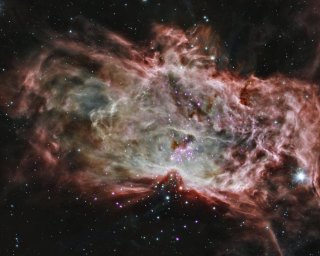Scientists shed new light on star formation

Astronomers are studying data to gain insight into how star clusters form. Image: NASA.
Simply put: Stars form clusters when a giant cloud of gas and dust condenses. The center of the cloud pulls in material from its surroundings until it becomes dense enough to trigger star formation. This occurs in the center of the cloud first, implying that the stars in the middle of the cluster are the oldest.
But data from NASA's Chandra X-ray Observatory and infrared telescopes suggest another scenario. Researchers studied two clusters where sunlike stars are forming – NGC 2024, in the center of the Flame Nebula, and the Orion Nebula Cluster. They discovered that stars on the outskirts of the clusters are the oldest.
Scientists first used Chandra data on the brightness of the stars in X-rays to calculate their masses. Then they determined how bright these stars were in infrared light using ground-based telescopes and data from NASA's Spitzer Space Telescope. By combining this information with theoretical models, the ages of the stars throughout the two clusters were estimated.
The results were contrary to what the basic model predicted. At the center of NGC 2024, the stars were about 200,000 years old, while stars on the outskirts were about 1.5 million years in age. In the Orion Nebula, star ages ranged from 1.2 million years in the middle of the cluster to almost 2 million years near the edges.
One explanation is that star formation continues to occur in the inner regions because the gas in the inner regions of a star-forming cloud is denser -- contains more material from which to build stars -- than the more diffuse outer regions.
Another idea is that old stars have had more time to drift away from the center of the cluster, or be kicked outward by interactions with other stars. It is also possible that young stars are formed in massive filaments of gas that fall toward the center of the cluster.
Previous studies of the Orion Nebula Cluster revealed hints of this reversed age spread, but these earlier efforts were based on limited or biased star samples. The latest research provides the first evidence of such age differences in the Flame Nebula.
But data from NASA's Chandra X-ray Observatory and infrared telescopes suggest another scenario. Researchers studied two clusters where sunlike stars are forming – NGC 2024, in the center of the Flame Nebula, and the Orion Nebula Cluster. They discovered that stars on the outskirts of the clusters are the oldest.
Scientists first used Chandra data on the brightness of the stars in X-rays to calculate their masses. Then they determined how bright these stars were in infrared light using ground-based telescopes and data from NASA's Spitzer Space Telescope. By combining this information with theoretical models, the ages of the stars throughout the two clusters were estimated.
The results were contrary to what the basic model predicted. At the center of NGC 2024, the stars were about 200,000 years old, while stars on the outskirts were about 1.5 million years in age. In the Orion Nebula, star ages ranged from 1.2 million years in the middle of the cluster to almost 2 million years near the edges.
One explanation is that star formation continues to occur in the inner regions because the gas in the inner regions of a star-forming cloud is denser -- contains more material from which to build stars -- than the more diffuse outer regions.
Another idea is that old stars have had more time to drift away from the center of the cluster, or be kicked outward by interactions with other stars. It is also possible that young stars are formed in massive filaments of gas that fall toward the center of the cluster.
Previous studies of the Orion Nebula Cluster revealed hints of this reversed age spread, but these earlier efforts were based on limited or biased star samples. The latest research provides the first evidence of such age differences in the Flame Nebula.
Like us on Facebook and tell us what you think.
Related:

